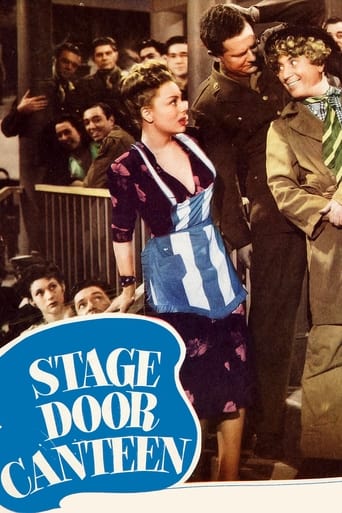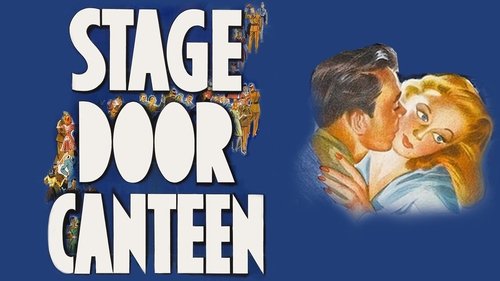lugonian
STAGE DOOR CANTEEN (United Artists, 1943), produced and directed by Frank Borzage, is not a sequel to the 1937 classic, STAGE DOOR, starring Katharine Hepburn. Though Hepburn does appear in this wartime musical with a huge all star cast, her role very much is brief, nearly coming towards the bitter end where she does her brief dramatic turn opposite the lead actress, Cheryl Walker. Following the tradition of other studios featuring all-star casts that started with STAR SPANGLED RHYTHM (Paramount, 1942), followed by a similar structure with HOLLYWOOD CANTEEN (Warner Brothers, 1944), United Artists contributed its services with STAGE DOOR CANTEEN with a handful of popular star performers of the day, ranging from motion pictures, theater or radio, entertainers doing either brief cameos or participation in a song or two, as part of the entertainment effort for the soldiers on leave during World War II.
The thin plot opens with Army soldiers on a train heading for an unknown destination. The soldiers in question are Ed "Dakota" Smith (William Terry), Jack "California" Gilman (Lon McCallister) who has never kissed a girl; "Texas" (Michael Harrison), "Jersey" Wallace (Fred Brady) and The Australian (Patrick O'Moore). Entering New York City for some recreation, the soldiers enter the Stage Door Canteen where they encounter many entertainers and working girls, one named Eileen (Cheryl Walker), who, at the risk of her losing her job, becomes a romantic interest with one the soldiers. Also in the story cast are Marjorie Riordan (Jean); Dorothea Kent (Mamie); Marion Shockley (Lillian) and Margaret Early (Ella Sue).
With plenty songs taking up much of the proceedings, the motion picture soundtrack and participants are as follows: "The Machine Gun Song" and "Our Father Prayer (both sung by Gracie Fields); "A Rookie and his Rhythm" and "Sleep Baby Sleep" (Kay Kyser Band); "The Girl I Love to Leave Behind" (Ray Bolger song and tap dance); "Goodnight, Sweetheart" (instrumental); "Sing Hallelujah" (Ethel Merman); "Bombshell from Brooklyn" (Xavier Cugat and Orchestra/Lina Romay); "U.S. Marine Song," "Sleep Baby Sleep" (Guy Lombardo and his Orchestra); "Goodnight, Sweetheart" (Kenny Baker); "Quicksand" (Ethel Waters); Gypsy Rose Lee specialty; "Don't Worry Island" (Freddie Martin and his Orchestra); "The Chinese Fighting March," "Old Acquaintance" (Guy Lombardo and his Orchestra); "We Mustn't Say Goodbye" (Kenny Baker); "Get Outta Here and Give Me Some Money" (Benny Goodman Orchestra/sung by Peggy Lee); "Heartful of Music" (instrumental, Benny Goodman Orchestra); Franz Shubert's "Ave Maria" (violin playing by Yehudi Menuhin); "The Flight of the Bumble Bee" and "Goodnight, Sweetheart." Of the handful of tunes, "We Mustn't Say Goodbye" got an Academy Award nomination as Best Song of 1943, though "Sing Hallelujah" and "Sleep, Baby, Sleep" are much more memorable.
Notable scenes include Katherine Cornell reciting her scene from "Romeo and Juliet," Alfred Lunt and Lynn Fontanne in rare screen appearance; George Jessel talking to his family in telephone booth between musical segments; and Hollywood in-joke on the movie's Tarzan, Johnny Weissmuller, being more natural by taking off his shirt while washing dishes in the kitchen with Franklin Pangborn; and of course Harpo Marx, of Marx Brothers fame, silently honking and chasing a girl. With the guest stars too numerous to mention, with Bert Lytell and Allen Jenkins acting as individual masters of ceremonies, other star performers inlude Tallulah Bankhead, George Raft, Helen Hayes, Merle Oberon, Aline MacMahon, Paul Muni, Ned Sparks and many others.
Since Frank Borzage is known for his sentimental touches, STAGE DOOR CANTEEN takes time away from song interludes for some serious moments involving the girl loving soldier theme; Sam Jaffe talking with refugees, and Katharine Hepburn being serious while consulting with Eileen's (Cheryl Walker) problem.
In spite of its great length (132 minutes) and the sort of wartime musical that cries for Technicolor, STAGE DOOR CANTEEN, especially with its star cast, simply reflects the times when ll Americans stood together as one during the war years. As being the sort of movie for the time capsule, it's no doubt highly entertaining, especially when movie star searching is concerned. Being a public domain title, it's become available on video cassette and public television dating back to the 1980s, followed by years later on DVD. It also has had its broadcasts on cable television, notably on American Movie Classics (1989-1990) and Turner Classic Movies. (***1/2)
jjnxn-1
The main story is mile high corn about being swept away by emotion during wartime but the cast roll is amazing as are some of the performances. In particular Peggy Lee, saucy and sexy, Ethel Waters who's full of snap and Kay Kyser's band who swing the place. There are some personalities who don't perform but swoop in an add a touch of spice then saunter back out, Tallulah Bankhead being the best example. Some of the stars are a bit stiff but that's natural considering most of them where stars of the stage not screen. This does provide a document for some, Helen Menken for one, of their only on screen appearance for others, The Lunts, etc. a very rare one. The film offers a window into the diversity of popular entertainment during the war years-from jitterbugging to classical music. Some stars appearances are mere bits, Dame May Witty and Aline MacMahon. While others show some of their famed act that could never make it past the censors otherwise, Gypsy Rose Lee's performance is the best example of this. Then there are a few performers who became better known to the general public when they were older, Helen Hayes among them, who it is fascinating to see in their younger years. Mixed in with all the marvelous array of talent and entertainment are heavy doses of patriotic speeches which of course was the whole point of the film. Some are low-key and some like Merle Oberon's call to arms more heavy handed. The picture holds its big gun at least as far as star wattage goes, Kate Hepburn, until almost the conclusion of the film. She delivers a flag waving speech which even though it's a tad awkward she saves by the look she delivers at the end of it. At times a trifle graceless and ham-fisted this is still a very enjoyable movie with an utterly charming scene between Katharine Cornell and Lon McCallister where they perform an impromptu scene from Romeo and Juliet, the best of many highlights.
secondtake
Stage Door Canteen (1943)This is not a great movie as movies go, but if you stick it out, you'll find an amazing parade of great music from the time, played by the real deals, from Benny Goodman to Count Basie. There are some small moments that are treasures, and they will vary depending on who you are. I know I absolutely get choked up in the short recital of Romeo and Juliet with the great Broadway star Katharine Cornell playing Juliet--behind the lunch counter. And there is Katherine Hepburn (at the end), and Yehudi Menuhin (violin and Schubert) and Ray Bolger (he was the Scarecrow four years earlier). There is a really touching moment with a group of Soviet soldiers including a young woman, whose eyes and story are just super sad...but she says, if she meets a Nazi, her "hand will not tremble."The soldiers are such regular guys, all sweetness and loneliness. It's a sad reminder of the war at its most basic--tearing young men from their innocence--and yet of course this is putting the best tilt to it all. These kinds of "canteens" were benefits of sorts, morale boosters, and this movie is a summation of that best of them. Frank Borzage (the director) was top flight a decade early (he did the famous 1932 "Farewell to Arms"), and the photography by Harry Wild (a studio mainstay) is great.Still, it's a canned affair. After an hour of entertainment there's an interlude out on the streets which is weak, and then they are back for more. There are two parallel stories outside the music--the soldiers who are about to go to war, and they are floating around fishing for company, and the women, back stage and in off hours. It's not bad stuff at all.
tavm
This is my fourth review of a "war musical"-having previously commented on Something for the Boys, Thank Your Lucky Stars, and This is the Army-that was made during and alluded to World War II. In this one, four G.I.'s are given a pass to New York and go the the title place where they have free refreshments and dances. Three of them meet the women who work there and they all seem to fall in love. That's all I'll mention of the plot which is more serious than the previous ones of the movies I just mentioned and as such there is more gravity concerning the dialogue when they discuss fates of what might happen. But that doesn't take away from the entertainment of seeing so many cameos of the various stars that appear here with plenty of good comedy and music that gives one pause constantly. I won't mention who they are (you probably know already if you've looked at the cast list or the other reviews near mine) but if you love this particular era of movies, you won't be disappointed when you see them. So on that note, I highly recommend Stage Door Canteen.




